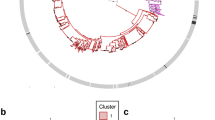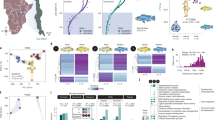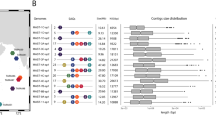Abstract
Methanogenic archaea are genotypically and phenotypically diverse organisms that are integral to carbon cycling in anaerobic environments. Owing to their genetic tractability and ability to be readily cultivated, Methanosarcina spp. have become a powerful model system for understanding methanogen biology at the cellular systems level. However, relatively little is known of how genotypic and phenotypic variation is partitioned in Methanosarcina populations inhabiting natural environments and the possible ecological and evolutionary implications of such variation. Here, we have identified how genomic and phenotypic diversity is partitioned within and between Methanosarcina mazei populations obtained from two different sediment environments in the Columbia River Estuary (Oregon, USA). Population genomic analysis of 56 M. mazei isolates averaging <1% nucleotide divergence revealed two distinct clades, which we refer to as ‘mazei-T’ and ‘mazei-WC’. Genomic analyses showed that these clades differed in gene content and fixation of allelic variants, which point to potential differences in primary metabolism and also interactions with foreign genetic elements. This hypothesis of niche partitioning was supported by laboratory growth experiments that revealed significant differences in trimethylamine utilization. These findings improve our understanding of the ecologically relevant scales of genomic variation in natural systems and demonstrate interactions between genetic and ecological diversity in these easily cultivable and genetically tractable model methanogens.
Similar content being viewed by others
Log in or create a free account to read this content
Gain free access to this article, as well as selected content from this journal and more on nature.com
or
References
Angiuoli SV, Salzberg SL . (2011). Mugsy: fast multiple alignment of closely related whole genomes. Bioinformatics 27: 334–342.
Aziz RK, Bartels D, Best AA, DeJongh M, Disz T, Edwards RA et al. (2008). The RAST server: rapid annotations using subsystems technology. BMC Genomics 9: 75.
Barrett RDH, Hoekstra HE . (2011). Molecular spandrels: tests of adaptation at the genetic level. Nat Rev Genet 12: 767–780.
Benedict MN, Henriksen JR, Metcalf WW, Whitaker RJ, Price ND . (2014). ITEP: an integrated toolkit for exploration of microbial pan-genomes. BMC Genomics 15: 8.
Bose A, Metcalf WW . (2008). Distinct regulators control the expression of methanol methyltransferase isozymes in Methanosarcina acetivorans C2A. Mol Microbiol 67: 649–661.
Bose A, Pritchett MA, Rother M, Metcalf WW . (2006). Differential regulation of the three methanol methyltransferase isozymes in Methanosarcina acetivorans C2A. J Bacteriol 188: 7274–7283.
Cadillo-Quiroz H, Didelot X, Held NL, Herrera A, Darling A, Reno ML et al. (2012). Patterns of gene flow define species of thermophilic archaea. PLoS Biol 10: e1001265.
Cohan FM, Koeppel AF . (2008). The origins of ecological diversity in prokaryotes. Curr Biol 18: R1024–R1034.
Coleman ML, Chisholm SW . (2010). Ecosystem-specific selection pressures revealed through comparative population genomics. Proc Natl Acad Sci USA 107: 18634–18639.
Cornejo OE, Lefébure T, Bitar PDP, Lang P, Richards VP, Eilertson K et al. (2013). Evolutionary and population genomics of the cavity causing bacteria Streptococcus mutans. Mol Biol Evol 30: 881–893.
Costa KC, Lie TJ, Xia Q, Leigh JA . (2013). VhuD facilitates electron flow from H2 or formate to heterodisulfide reductase in Methanococcus maripaludis. J Bacteriol 195: 5160–5165.
Costa KC, Wong PM, Wang T, Lie TJ, Dodsworth JA, Swanson I et al. (2010). Protein complexing in a methanogen suggests electron bifurcation and electron delivery from formate to heterodisulfide reductase. Proc Natl Acad Sci USA 107: 11050–11055.
Darling ACE, Mau B, Blattner FR, Perna NT . (2004). Mauve: multiple alignment of conserved genomic sequence with rearrangements. Genome Res 14: 1394–1403.
Darling AE, Mau B, Perna NT . (2010). progressiveMauve: multiple genome alignment with gene gain, loss and rearrangement. PLoS ONE 5: e11147.
Deppenmeier U, Johann A, Hartsch T, Merkl R, Schmitz RA, Martinez-Arias R et al. (2002). The genome of Methanosarcina mazei: evidence for lateral gene transfer between bacteria and archaea. J Mol Microbiol Biotechnol 4: 453–461.
Eggen RIL, Geerling ACM, PWJD Groot, Ludwig W, De Vos WM . (1992). Methanogenic bacterium Gö1: an acetoclastic methanogen that is closely related to Methanosarcina frisia. Syst Appl Microbiol 15: 582–586.
Ellison CE, Hall C, Kowbel D, Welch J, Brem RB, Glass NL et al. (2011). Population genomics and local adaptation in wild isolates of a model microbial eukaryote. Proc Natl Acad Sci USA 108: 2831–2836.
Enright AJ, Van Dongen S, Ouzounis CA . (2002). An efficient algorithm for large-scale detection of protein families. Nucleic Acids Res 30: 1575–1584.
Excoffier L, Lischer HEL . (2010). Arlequin suite ver 3.5: a new series of programs to perform population genetics analyses under Linux and Windows. Mol Ecol Resour 10: 564–567.
Ferry JG . (1993) Methanogenesis: Ecology, Physiology, Biochemistry & Genetics. Chapman & Hall: New York.
Field CB, Behrenfeld MJ, Randerson JT, Falkowski P . (1998). Primary production of the biosphere: integrating terrestrial and oceanic components. Science 281: 237–240.
Finn RD, Tate J, Mistry J, Coggill PC, Sammut SJ, Hotz H-R et al. (2008). The Pfam protein families database. Nucleic Acids Res 36: D281–D288.
Fournier GP, Gogarten JP . (2007). Evolution of acetoclastic methanogenesis in methanosarcina via horizontal gene transfer from cellulolytic clostridia. J Bacteriol 190: 1124–1127.
Grissa I, Vergnaud G, Pourcel C . (2007). CRISPRFinder: a web tool to identify clustered regularly interspaced short palindromic repeats. Nucleic Acids Res 35: W52–W57.
Guss AM, Kulkarni G, Metcalf WW . (2009). Differences in hydrogenase gene expression between Methanosarcina acetivorans and Methanosarcina barkeri. J Bacteriol 191: 2826–2833.
Hartl D, Clark A . (1998) Principles of Population Genetics 3rd edn Sinauer Associates: Sunderland, MA.
Hedderich R, Whitman W . (2006). Physiology and biochemistry of the methane-producing Archaea. Prokaryotes 2: 1050–1079.
Ito A, Inatomi M . (2012). Use of a process-based model for assessing the methane budgets of global terrestrial ecosystems and evaluation of uncertainty. Biogeosciences 9: 759–773.
Kandler O, Hippe H . (1977). Lack of peptidoglycan in the cell walls of Methanosarcina barkeri. Arch Microbiol 113: 57–60.
Katoh K, Standley DM . (2013). MAFFT multiple sequence alignment software version 7: improvements in performance and usability. Mol Biol Evol 30: 772–780.
Kendall MM, Boone DR . (2006). The order methanosarcinales. Prokaryotes 3: 244–256.
Kohler PRA, Metcalf WW . (2012). Genetic manipulation of Methanosarcina spp. Front Microbiol 3: 259.
Korber B . (2000). HIV signature and sequence variation analysis. Comput Anal HIV Mol Seq 4: 55–72.
Krätzer C, Carini P, Hovey R, Deppenmeier U . (2009). Transcriptional profiling of methyltransferase genes during growth of Methanosarcina mazei on trimethylamine. J Bacteriol 191: 5108–5115.
Kryazhimskiy S, Plotkin JB . (2008). The population genetics of dN/dS. PLoS Genet 4: e1000304.
Krzywinski M, Schein J, Birol İİ, Connors J, Gascoyne R, Horsman D et al. (2009). Circos: an information aesthetic for comparative genomics. Genome Res 19: 1639–1645.
Langille MGI, Brinkman FSL . (2009). IslandViewer: an integrated interface for computational identification and visualization of genomic islands. Bioinformatics 25: 664–665.
Liu Y, Whitman WB . (2007). Metabolic, phylogenetic, and ecological diversity of the methanogenic archaea. Ann N Y Acad Sci 1125: 171–189.
Maeder DL, Anderson I, Brettin TS, Bruce DC, Gilna P, Han CS et al. (2006). The Methanosarcina barkeri genome: comparative analysis with Methanosarcina acetivorans and Methanosarcina mazei reveals extensive rearrangement within methanosarcinal genomes. J Bacteriol 188: 7922–7931.
Mah RA, Smith MR . (1981). The methanogenic bacteria. In: Starr MP, Stolp H, Trüper HG, Balows A, Schlegel HG (eds) The Prokaryotes. Springer: Berlin Heidelberg, pp 948–977.
Mao F, Williams D, Zhaxybayeva O, Poptsova M, Lapierre P, Gogarten JP et al. (2012). Quartet decomposition server: a platform for analyzing phylogenetic trees. BMC Bioinform 13: 123.
Marchler-Bauer A, Anderson JB, Cherukuri PF, DeWeese-Scott C, Geer LY, Gwadz M et al. (2005). CDD: a conserved domain database for protein classification. Nucleic Acids Res 33: D192–D196.
Metcalf WW, Zhang JK, Shi X, Wolfe RS . (1996). Molecular, genetic, and biochemical characterization of the serC gene of Methanosarcina barkeri Fusaro. J Bacteriol 178: 5797–5802.
Nguyen TH, Ranwez V, Pointet S, Chifolleau A-MA, Doyon J-P, Berry V . (2013). Reconciliation and local gene tree rearrangement can be of mutual profit. Algorithms Mol Biol 8: 12.
Nickel L, Weidenbach K, Jäger D, Backofen R, Lange SJ, Heidrich N et al. (2013). Two CRISPR-Cas systems in Methanosarcina mazei strain Gö1 display common processing features despite belonging to different types I and III. RNA Biol 10: 779–791.
Nosil P, Funk DJ, Ortiz-Barrientos D . (2009). Divergent selection and heterogeneous genomic divergence. Mol Ecol 18: 375–402.
Ochman H, Lawrence JG, Groisman EA . (2000). Lateral gene transfer and the nature of bacterial innovation. Nature 405: 299–304.
Opulencia RB, Bose A, Metcalf WW . (2009). Physiology and posttranscriptional regulation of methanol:coenzyme M methyltransferase isozymes in Methanosarcina acetivorans C2A. J Bacteriol 191: 6928–6935.
Paul L, Ferguson DJ, Krzycki JA . (2000). The trimethylamine methyltransferase gene and multiple dimethylamine methyltransferase genes of Methanosarcina barkeri contain in-frame and read-through amber codons. J Bacteriol 182: 2520–2529.
R Development Core Team. (2010) R: A Language and Environment for Statistical Computing. Vienna: Austria, http://www.R-project.org.
Riley WJ, Subin ZM, Lawrence DM, Swenson SC, Torn MS, Meng L et al. (2011). Barriers to predicting changes in global terrestrial methane fluxes: analyses using CLM 4 Me, a methane biogeochemistry model integrated in CESM. Biogeosci Discuss 8: 1733–1807.
Schloss PD, Westcott SL, Ryabin T, Hall JR, Hartmann M, Hollister EB et al. (2009). Introducing mothur: open-source, platform-independent, community-supported software for describing and comparing microbial communities. Appl Environ Microbiol 75: 7537–7541.
Schmitz RA, Albracht SPJ, Thauer RK . (1992a). A molybdenum and a tungsten isoenzyme of formylmethanofuran dehydrogenase in the thermophilic archaeon Methanobacterium wolfei. Eur J Biochem 209: 1013–1018.
Schmitz RA, Albracht SPJ, Thauer RK . (1992b). Properties of the tungsten-substituted molybdenum formylmethanofuran dehydrogenase from Methanobacterium wolfei. FEBS Lett 309: 78–81.
Shapiro BJ, Friedman J, Cordero OX, Preheim SP, Timberlake SC, Szabó G et al. (2012). Population genomics of early events in the ecological differentiation of bacteria. Science 336: 48–51.
Shapiro BJ, Polz MF . (2014). Ordering microbial diversity into ecologically and genetically cohesive units. Trends Microbiol 22: 235–247.
Shimizu S, Upadhye R, Ishijima Y, Naganuma T . (2011). Methanosarcina horonobensis sp. nov., a methanogenic archaeon isolated from a deep subsurface Miocene formation. Int J Syst Evol Microbiol 61: 2503–2507.
Söding J . (2005). Protein homology detection by HMM–HMM comparison. Bioinformatics 21: 951–960.
Sowers KR, Baron SF, Ferry JG . (1984). Methanosarcina acetivorans sp. nov., an acetotrophic methane-producing bacterium isolated from marine sediments. Appl Environ Microbiol 47: 971–978.
Stamatakis A . (2006). RAxML-VI-HPC: maximum likelihood-based phylogenetic analyses with thousands of taxa and mixed models. Bioinforma Oxf Engl 22: 2688–2690.
Suyama M, Torrents D, Bork P . (2006). PAL2NAL: robust conversion of protein sequence alignments into the corresponding codon alignments. Nucleic Acids Res 34: W609–W612.
Tatusov RL, Galperin MY, Natale DA, Koonin EV . (2000). The COG database: a tool for genome-scale analysis of protein functions and evolution. Nucleic Acids Res 28: 33–36.
Thauer RK . (1998). Biochemistry of methanogenesis: a tribute to Marjory Stephenson:1998 Marjory Stephenson Prize Lecture. Microbiology 144: 2377–2406.
Vestergaard G, Garrett RA, Shah SA . (2014). CRISPR adaptive immune systems of archaea. RNA Biol 11: 156–167.
Wania R, Ross I, Prentice IC . (2010). Implementation and evaluation of a new methane model within a dynamic global vegetation model: LPJ-WHyMe v1.3.1. Geosci Model Dev 3: 565–584.
Wickham H . (2009) ggplot2: Elegant Graphics for Data Analysis. Springer: New York.
Acknowledgements
We thank Maya Errabolu for helping collect gas chromatography measurements, Gargi Kulkarni for isolating M. mazei WWM610 and everyone involved in the Genomes to Life: Biological Systems Research on the Role of Microbial Communities in Carbon Cycling project, especially Matt Benedict, Judy Luke and Sarah Reinhart. We also thank Mary Elizabeth Metcalf, Nicolai Müller, Petra Kohler, Madeline López-Muñoz, Thom Mand, Andrew He Fu and Jeremy Ellermeier for providing assistance with anaerobic cultivation and gas chromatography analysis. This material is based on work supported in part by the Department of Energy under grant no. DE-SC0005348.
Author information
Authors and Affiliations
Corresponding author
Ethics declarations
Competing interests
The authors declare no conflict of interest.
Additional information
Supplementary Information accompanies this paper on The ISME Journal website
Supplementary information
Rights and permissions
About this article
Cite this article
Youngblut, N., Wirth, J., Henriksen, J. et al. Genomic and phenotypic differentiation among Methanosarcina mazei populations from Columbia River sediment. ISME J 9, 2191–2205 (2015). https://doi.org/10.1038/ismej.2015.31
Received:
Revised:
Accepted:
Published:
Issue date:
DOI: https://doi.org/10.1038/ismej.2015.31
This article is cited by
-
Population differentiation of Rhodobacteraceae along with coral compartments
The ISME Journal (2021)
-
Biomethane production from sugar beet pulp under cocultivation with Clostridium cellulovorans and methanogens
AMB Express (2019)
-
Reconstruction of real and simulated phylogenies based on quartet plurality inference
BMC Genomics (2018)
-
Genomic composition and dynamics among Methanomicrobiales predict adaptation to contrasting environments
The ISME Journal (2017)
-
Genome-wide gene expression and RNA half-life measurements allow predictions of regulation and metabolic behavior in Methanosarcina acetivorans
BMC Genomics (2016)



